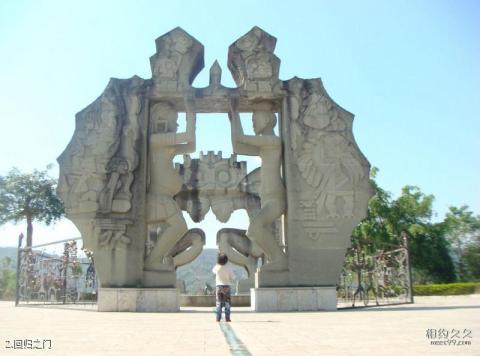
Introduction to the Gate of Return: The circular arch symbolizes the earth’s orbit. The line inlaid with glass in the middle is the Tropic of Cancer. Every year on June 21st or June 22nd in the Gregorian calendar, the sun will shine directly. On the Tropic of Cancer. There are seven giant stone paintings carved on the wall of the ascending steps behind the Gate of Return. The first stone painting shows a sun in the middle, surrounded by a flock of white pheasants. It means that the Hani people are a nation that worships the sun, and their mascot is the white pheasant bird, known as the "Prince of Birds". The second stone painting shows that the Hani people are a people living on the mountainside. They are hardworking and brave. They have created the world-famous "terraced field culture" with their hard-working hands. The third stone painting shows that the ancestors of the Hani people once lived in a place called "Noma Ame", where there were clouds, mist and streams. The fourth stone painting shows that the white pheasant is the mascot of the Hani people. Legend has it that a long time ago, an old man named Hani'ab went hunting in the mountains. He was exhausted after walking over the mountains and ridges, and then he fainted under a big tree. It happened that there was a beautiful white pheasant perched on the tree, and it brought precious pheasants in its mouth. The medicinal herbs were given to Abu, and Hani Abu was miraculously saved. The white pheasant bird danced beside him to celebrate. Since then, the Hani people have regarded the white pheasant as an auspicious bird, which brings good luck, happiness and peace to the Hani people. The fifth stone painting shows the Hani people worshiping the sun. In the hearts of the Hani people, the sun is a god who is not angry but powerful. It has thick long eyebrows that curl to the ends of the eyes, huge nostrils, and a huge mouth that can swallow everything. The sixth stone painting "White Pheasant at the top, White Tiger at the bottom" shows that the Hani and Yi people are from the same family. The white pheasant represents the Hani people and the white tiger represents the Yi people. As early as ancient times, the Hani and Yi people both belonged to the Diqiang ethnic group, and there was a saying among the people that "Haniha Oqi Maran". Later, during the long journey southward, they gradually separated and formed different ethnic groups. The Hani and Yi people lived in harmony and developed together. The seventh stone painting is the sun. The sun is the mother of all things. It emits endless light and gives birth to all living things on the earth.
